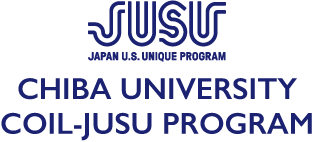Politics of the Middle East and US-Japan Relations
Partner university (faculty)
Faculty of Law, College of Liberal Arts and Sciences, Chiba University and The University of Alabama
Class schedule
Saturday, February 6 to Tuesday, March 30
Time difference
15 hours
Class objectives
This class seeks to recognize the differences in political views between Japanese and American societies toward the Middle East and deepen the understanding of the relationship between Japan and the US concerning the Middle East.
Class content
February 6-18: Students conducted group work after studying their individually assigned portions by using the e-learning teaching materials on Google Classroom and shared the results within each group on Google Drive.
March 3-5: Students took part in international collaborative learning using COIL-Moodle. The topic is "Can we call Japan a 'peaceful' nation?," and they explained the attitude of Japan toward the use of military force to the students from the University of Alabama and had an asynchronous discussion with them.
March 10: Students took part in international collaborative learning in real time using Zoom. The students of Chiba University were divided into three groups and gave presentations respectively on "Japan's media coverage of the relocation of the US Embassy to Jerusalem," "Japan's media reports on the killing of Commander Soleimani," and "Japan's media coverage on the Arab Spring." In addition, we asked the students of the University of Alabama for their comments.
March 24-26: The students took part in international collaborative learning by utilizing COIL-Moodle. The topic is about the differences in the perceptions and situation between Japan and the US, which had been shared through the second international collaborative learning, the students asynchronously discussed how they should evaluate the notion that the contribution of Japan to the Gulf War has been limited to an economic one.
March 30: We recapped and reviewed the class as a whole using Zoom.
Class format
Synchronous and asynchronous
Tools used
Zoom, Google Classroom, COIL-Moodle
We combined multiple asynchronous activities and narrowed down those that we would conduct synchronously to overcome the time difference. Careful preparation enhanced the quality of the time which was used for the simultaneous two-way workshops conducted on Zoom.
実施大学(学部)
千葉大学法政経学部・国際教養学部 アラバマ大学
授業日程
2月6日(土)~3月30日(火)
時差
15時間
授業目的
中東政治に対する日米両国(社会)の見方の違いを認識し、中東をめぐる日米関係への理解を深める。
授業内容
2/6-2/18:事前学修としてGoogle Classroom上のe-learning教材を用いて、グループごとに分担で学習した後、グループワークを行い、グループ内で成果をGoogle Driveで共有した。
3/3-3/5: COIL-Moodleを用いて国際協働学修を行った。「日本は「平和国家」と言えるか?」をテーマに日本の武力行使への姿勢をアラバマ大学の学生に説明しつつ、非同期で議論した。
3/10: Zoomを用いてリアルタイムで国際協働学修を行った。千葉大生は3グループに分かれ、「アメリカ大使館のエルサレムへの移転に関する日本の報道」、「ソレイマニ司令官殺害に関する日本での報道」、「日本における『アラブの春』に関する報道」についてプレゼンテーションを行い、アラバマ大生からコメントをもらった。
3/24-3/26:COIL-Moodleを用いて国際協働学修を行った。2回の国際協働学修を通じて共有した日米の認識や状況の違いを踏まえ、湾岸戦争における日本の貢献が経済的な貢献に限定されたことについて、どのように評価すべきかを非同期で議論した。
3/30:Zoomを用いて、授業全体のまとめと振り返りを行った。
授業実施形態
同期型および非同期型
使用ツール
Zoom, Google Classroom, COIL-Moodle
時差を克服するため、複数の非同期型の活動を組み合わせ、同期型で行う活動を絞り込んだ。入念な準備に取り組んだことがZoomによる同時双方向のワークショップを行う時間を充実させた。

